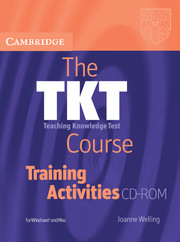3.3 - Who says what and why?
Published online by Cambridge University Press: 09 February 2024
Summary
Instructions
1. Review the terms function and exponent from Module 1 Part 1. Establish the relationship between them by eliciting a function and various exponents of it.
2. Explain that in Module 3 of the TKT, candidates are tested on classroom functions. Elicit a definition of this term (e.g. teachers’ and learners’ reasons to communicate when in a lesson) and give some example exponents (e.g. Can you open your books now / Swap places A and B / May I go to the bathroom, please?). Have students name the corresponding function (e.g. Giving instructions / Asking for permission).
3. Divide the class into groups of three or four. Hand out one set of cards to each group and ask them to sort the cards into three piles: Teachers’ Language (on the left), Learners’ Language (on the right) and Both (in the middle). Allow five minutes. Monitor and ask prompting questions if necessary.
4. When the group is satisfied (and there are no obvious mistakes that the trainer can correct) ask trainees to look at all the exponents in the Learners’ Language column. Trainees take it in turns to name the function for each exponent, e.g. May I take a dictionary, please? is Asking for permission.
5. Monitor and prompt or correct as necessary.
6. Divide the class in two. Have half the groups looking at the teachers’ language column and half the groups looking at the both column. Hand out a set of blank cards to each group. Explain that each group should identify the function for each exponent and write it on a blank card. Monitor and check that the functions are correct.
7. Have each group swap its cards with a group that looked at the other column. The trainees’ task is to match the exponents to the functions. Encourage the groups to check each other's answers and discuss any disagreements.
- Type
- Chapter
- Information
- The TKT Course Training Activities , pp. 72 - 73Publisher: Cambridge University PressFirst published in: 2024

